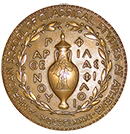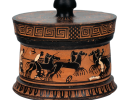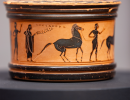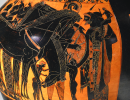“Then at the sound of the bronze trumpet, they started. All shouted to their horses, and shook the reins in their hands; the whole course was filled with the clatter of rattling chariots; and the dust flew upward. All of them in a confused throng kept plying their goads unsparingly, so that one of them might pass the wheel-hubs and the snorting steeds of his rivals; for both at their backs and at their rolling wheels the breath of the horses foamed and smattered. Orestes, driving close to the near edge of the turning-post, almost grazed it with his wheel each time and, giving rein to the trace-horse on the right, he checked the horse on the inner side. To this point, all the chariots still stood upright. But then the Aenian’s hardmouthed colts carried him out of control as they passed out of the turn from the sixth into the seventh lap and dashed their foreheads against the rig of the Barcaean. Next, as a result of this one mishap, the cars kept smashing and colliding with each other, and the whole race-ground of Crisa swelled with shipwrecked chariots”.
Sophocles, Electra
Horses are born to run and this characteristic was not lost on the Athenians who clearly enjoyed sponsoring, watching, and participating in a great variety of equestrian contests. Horses were rarely used as draft animals; rather they were bred for speed and endurance, the race track rather than the plough. Depictions of horse races are popular in a variety of media, but are especially prevalent on Athenian vases of the sixth century BCE, where they decorate shapes ranging from large amphoras to small pyxis lids.
Horse and chariot races were part of the Panhellenic games (Olympic, Pythian, Isthmian, Nemean) and other local festivals, like the Panathenaia in Athens. These races included ones for single horses (keles), two-horse chariots (synoris), four-horse chariots (tethrippon), and special events for warriors (polemisteriois). There were contests for full-grown horses and for colts. Horse races took place in special stadiums called hippodromes. At either end of the hippodrome were posts that marked the turns for the contestants. The winner of the race was the owner of the winning horse(s), and not the jockey or the driver of the chariot. Eminent and rich Athenians such as the generals Kimon and Alkibiades raced chariots at Olympia; to ensure victory the latter entered seven chariots which placed first, second and fourth in the Olympics of 416 BCE. After these wins, he commissioned a painting to be displayed on the Acropolis of his further wins at the Pythian and Nemean games. That he may also have won a chariot race at the Panathenaia in 418 BCE is suggested by the 82 Panathenaic prize amphoras auctioned off from his estate. Although women were not allowed to participate in horse races, they could be announced victors as owners of the winning horses. Those who won at races would erect monuments, like statues, to commemorate their victory, and commission victory odes from poets like Pindar.
Particular to Athens was the apobatesor ‘dismounting’ contest in which armed warriors riding on chariots driven by charioteers leapt on and off their vehicles as they raced through the market place or Agora. This contest was singled out by Demosthenes (Erotikos 61.23) as “the noblest and grandest of competitive exercises... one which approximates to the realities of warfare”. This relief resembles the race as depicted on the north and south friezes of the Parthenon. The base carried a monument to honor the victory of a man in the apobates race. The inscription at the top names the winning dismounter: KRATES, son of Heortios of Piraeus.
Base with apobates race Pentelic marble, 4thcentury BCE - Agora Excavations S 399
Ephorate of Antiquities of the City of Athens











